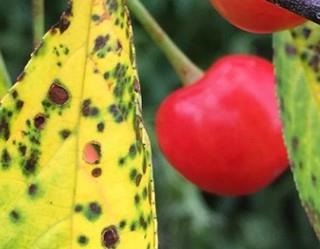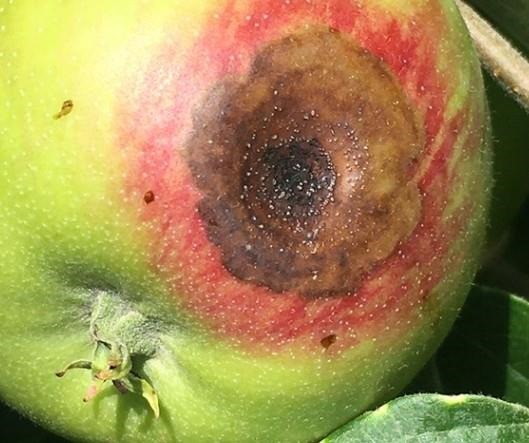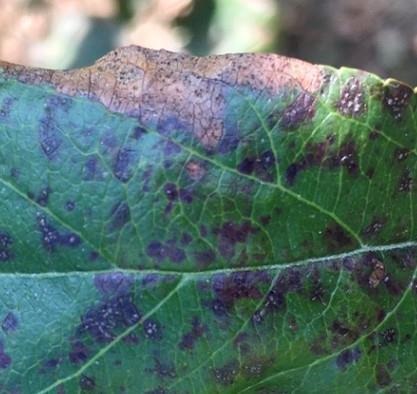By Kari A. Peter
Conditions have been favorable for bitter rot and apple blotch disease, and growers need to be vigilant with management, especially during frequent rain events. Tart cherries need postharvest fungicide applications to limit cherry leaf spot disease.
Managing Brown Rot on Stone Fruit
Peaches and nectarines are ripening, which means 'tis the season for brown rot. The fungus causing brown rot is quite opportunistic. It can kill blossoms and ruin the fruit you have worked hard all season to grow. Brown rot disease is favored by warm, wet weather conditions. Under optimum temperature conditions, fruit infections can occur with only three hours of wetness when inoculum levels are high. Longer wet periods during infection result in shorter incubation times, so symptoms develop more rapidly. It is not uncommon to have brown rot appear “overnight” on fruit.
Spores produced on early maturing cultivars can fuel a continuing outbreak on late maturing cultivars—this is especially important for those who have battled rot infections already this season. To add another headache to the issue, insects can be important vectors of the fungal spores during fruit ripening. They can carry spores to injury sites produced by oriental fruit moth, Japanese beetle, green June beetle, and other insects that can injure fruit. Wounded fruit are much more susceptible to brown rot than unwounded fruit. It is critical to be on top of insect management. Another concern to worry about is split pit. Unfortunately, these fruit are quite prone to rot problems. Keep in mind that under the right conditions, “healthy” fruit harvested can be contaminated and may decay later during storage.
This is a reminder of how to approach preharvest brown rot management. Brown rot sprays 18 days, nine days, and one day before harvest. Research at Rutgers showed applying sprays at 18, 9, and 1 day before harvest provided greater than 95 percent control of brown rot under heavy disease pressure. When following this regime, be sure to rotate chemistries by FRAC Group number for resistance management. For example, one could spray the following (provided the maximum number of sprays has not been exceeded for that chemistry):
- 18 days: Fontelis (FRAC Group 7; 0 day PHI)
- 9 days: Indar (FRAC Group 3; 0 day PHI)
- 1 day: Merivon (FRAC Group 7 +11; 0 day PHI)
Other options to rotate:
- Miravis (FRAC Group 7; 7 day PHI)
- Luna Sensation (FRAC Group 7 + 11; 1 day PHI)
- Luna Experience (FRAC Group 7 + 3; 0 day PHI)
- Pristine (FRAC Group 7 + 11; 0 day PHI
- Topsin M (FRAC Group 1; 1 day PHI)
- Cevya (FRAC Group 3; 0 day PHI)
- Inspire Super (FRAC Groups 3 + 9; 2 day PHI)
- Tilt (FRAC Group 3; 0 day PHI)
- Quash (FRAC Group Code 3; 14 day PHI)
- Vangard (FRAC Group 9; 2 day PHI)
- Flint Extra (FRAC Group 11; 0 day PHI)
- Captan (FRAC Group M4; 0 day PHI)
Be mindful of the products used to control blossom blight, and be sure to comply by obtaining the current usage regulations and reading the product label. Depending on the number of sprays needed and what you may have used during bloom time, be sure to practice fungicide resistance management and rotate chemistries by FRAC group (“Spray by the Numbers”). If captan was sprayed during the cover sprays, tank mixing is not necessary during the preharvest period.
Alternative options for brown rot management
The key for growers who farm organically or prefer using alternative products is to spray as often as possible as disease conditions persist, manage insects, scout often, and prompt removal of infected fruit as soon as you see it. Spraying often ensures you have continuous protection; removing infected fruit from the trees ensures you are decreasing the number of spores available to cause disease and hopefully minimizing an epidemic. Knocking infected fruit to the ground will be enough to limit its spread. Vigilance is important, which may translate to spraying every few days, especially if rain washes off products. According to studies at Rutgers, sulfur is ineffective for controlling brown rot. Some organic options labeled for brown rot control are Serenade (Opti or ASO), Double Nickel, Cueva, and Oso.
Cherry Leaf Spot
Management needed postharvest
Even if your trees are free of cherry leaf spot, disease management is still necessary after harvest since conditions will continue to persist. Growers are encouraged to apply two postharvest fungicide applications to prevent cherry leaf spot infection. The goal for the remainder of the season is to keep those leaves on the trees and prevent premature defoliation due to cherry leaf spot infection. Tart cherry trees should not be bald in August. This will stress trees setting them up for a weakened condition as they enter the winter months. Many options are available, such as Bravo, Topsin, Indar, Merivon, and Syllit, to name a few.

Figure 2. Limit cherry leaf spot defoliation of tart cherry trees by making two postharvest fungicide applications. Photo: K. Peter, Penn State
Bitter Rot Management
Conditions have been favorable for infection
Just a reminder, the conditions have been favorable for bitter rot in 2022. Infections have already been observed on immature fruit. When the spore penetrates the skin, the infection will then go dormant (quiescent phase) for a period of time. During this time, the spore does not grow and is not susceptible to fungicides. Consequently, fungicides must be applied before the initial infection of the spore. In contrast to apple scab, you cannot count on fungicides to successfully control the bitter rot fungus post-infection. Maturity of the fruit, temperature, humidity, and presence of disease are factors that determine when the quiescent period ends and the disease symptoms manifest. By the time you see symptoms, it is too late for disease control.

Figure 3. Conditions have been favorable for bitter rot. Be sure to apply fungicides before a rain event to limit disease. Photo: K. Peter, Penn State
Over the last several years, we have been studying how to best manage bitter rot. Our research to date has shown that the bitter rot spores are available all season long, most likely residing throughout the tree in buds and mummified fruit left in the tree. The spores are dispersed by rainwater, and high disease pressure is favored by warm temperatures and prolonged periods of moisture. We have shown that fruit are most susceptible to infection when these conditions are most favorable, typically from late June through harvest.
During this period, growers are encouraged to apply fungicides before the infection period (i.e., rain events). We have studied all the fungicides available to date labeled for apples and have identified those that are best for managing bitter rot. Captan (2-3 lb/A) is still the best bet for managing bitter rot. However, during frequent rain events, captan will eventually wash off. During these events, growers are encouraged to tank mix one of the following with captan (2-3 lb/A) that will offer a bit more control during:
- Aprovia (FRAC 7; 30 day PHI)
- Omega (FRAC 29; 28 day PHI; Use at 13.8 fl oz/A)
- Flint Extra (FRAC 11; 14 day PHI)
- Luna Sensation (FRAC 7 + 11; 14 day PHI)
- Merivon (FRAC 7 + 11; 0 day PHI)
Be sure to rotate FRAC groups for fungicide resistance management. Growers need to keep in mind what was applied in the early season to manage apple scab since FRAC 7 and FRAC 11 fungicides, regardless if they are in a premix or by themselves, are limited to four complete spray applications per year. If there are multiple rain events in one week, be mindful of the amount of rain that has fallen and when the fungicide was last applied. This will determine if reapplication is necessary during this time.
Additional products can be added that have been observed to help with bitter rot management. Research in the Southeastern U.S. has shown the addition of phosphorous acid-based products (Rampart, ProPhyt, etc.) helps with bitter rot control. We are currently evaluating these products under PA conditions. We have also observed Regalia (1-2 qt/A), tank mixed with a conventional spray application, gives an added boost in protection. This application would be most beneficial during seasons with frequent rain events, such as the summer of 2018. Organic options are limited. We have observed control using sulfur. However, sulfur can cause fruit russeting when temperatures are at 80°F or higher. Bacterial-based products, such as Serenade and Double Nickel have offered limited rot protection but must be applied repeatedly since these products can be washed off easily. We are currently researching additional alternatives to increase the tools in the grower toolbox.
Beware Of Apple Blotch: Marssonina Disease
Early symptoms of apple (Marssonina) blotch are being observed across multiple cultivars. The goal for management at this point in the season is to limit defoliation. The fungus that causes apple blotch can defoliate trees very quickly during a heavy infestation. It is critical growers do not let their fungicide applications lapse during the summer, especially after heavy rain events. The best options for management include broad-spectrum fungicides, such as captan or ziram. If ziram is being used, be sure to include a spreader sticker (e.g., Nu-Film P, Tactic, etc.). We have some preliminary data indicating there are effective products that could be good tank mixing partners with captan or ziram. These include:
- Topsin M (FRAC 1; 1 day PHI)
- Cevya (FRAC 3; 0 day PHI)
- Trionic/Procure (FRAC 3; 14 day PHI)
- Aprovia (FRAC 7; 30 day PHI)
- Fontelis (FRAC 7; 28 day PHI)
- Miravis (FRAC 7; 30 day PHI)
- Sercadis (FRAC 7; 0 day PHI)
- Omega (FRAC 29; 28 day PHI; Use at 13.8 fl oz/A)
- Luna Sensation (FRAC 7 + 11; 14 day PHI)
- Merivon (FRAC 7 + 11; 0 day PHI)
Use caution when alternate row middle sprays are used during rainy periods. This disease manifests fast when conditions are favorable. Regarding organic options, sulfur is the most effective product we have identified to date.

Figure 4. Keep trees protected from apple blotch, and don’t let fungicide protection of lapse. Photo: K. Peter, Penn State
Commercial fruit growers, please note
When controlling for disease, weather and tree growth conditions need to be monitored at a local level within one's own orchard. To assist with management decisions (especially infection events), growers can use the NEWA website, which has weather stations all over Pennsylvania. Before chemical products are applied, be sure to comply by obtaining the current usage regulations and examining the product label. Product information can be easily obtained from CDMS.
Source : psu.edu